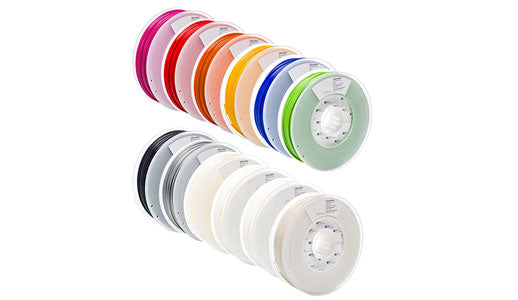Overview
Potterbot Scara Mini V1
The Scara Mini V1 is capable of large-scale ceramic 3D printing using real clay. The advanced design and substantial construction can handle on board loads like the 3D Potter 3600ml clay extruder or a hose assembly.
User interface (WiFi)
Duet Web Control is a fully developed UI for the Scara. Opened in a web browser, it can be used on your laptop, tablet, phone, or other WiFi capable device.
Print Status
Once a print is started, it shows information about the model being printed. Layer times, estimated time remaining, file information, and more are available for view. It also allows for print and extrusion speed control to be adjusted in real time.
G-Code Files
The G-Code Files interface enables you to upload, modify, and download g-code files for printing. It provides a brief overview of each file, including details like file size, layer height, and the software that generated it.
Software requirements
No additional software needed! Simply use a web browser interface.
In terms of object creation, the Scara Mini V1 shares similarities with other ceramic printers in the 3D Potter range. Like most 3D printers, it necessitates an STL file, which can be sliced using a third-party software. We suggest using Simplify3D or Cura for this purpose. Once completed, transfer the file to the printer's SD card through WiFi, and you're all set!
Build envelope
Featuring a distinct build envelope, the Scara Mini V1 ceramic 3D printer can print at 360 degrees through uninterrupted rotation. This enables the creation of large containers or structures, with the printer initially positioned inside them. Consequently, this offers a new possibility for printing small habitation structures or houses. For projects involving potential habitat construction, larger printers are also available.
A distinct feature of this product is its capacity to print numerous items sequentially within the given dimensions. For example, you can start by printing a specific container on the far left side, and proceed to print more of these containers until the available space is fully utilized.
Drive Mechanisms
Introducing a powerful, purpose-built robotic machine, designed specifically for heavy-duty tasks. Equipped with advanced harmonic drive units, this is far more than just a 3D printer. The same drives are employed in large-scale industrial robots found in major manufacturing facilities worldwide. These robust drives enable ultra-precise movements, down to a fraction of a degree in seconds, ensuring efficiency and accuracy.
This ensures highly accurate prints without any wobbling or unstable motions at feasible speeds. These drives are engineered for optimal sturdiness while maintaining exceptional precision.
Speed and Noise
The Scara Mini V1, is a ceramic 3D printer designed for impressive performance. While it can reach remarkable speeds, its optimal functioning is best realized at speeds up to 130 mm/s. Factors such as nozzle size, layer height, and clay interlayer adhesion contribute to determining its ideal operational speed.
What's more, the Scara Mini V1 operates with minimal noise, ensuring a peaceful environment wherever it's used.
Construction and Design
Introducing the large Scara arm robot by 3D Potter, a marvel of precision and accuracy, made possible through meticulous design and sturdy construction methods.
Constructed primarily from durable, aircraft-grade 6061 aluminum, this robot relies on CNC and welded components to ensure top-notch strength and stability. The main rail elements are sourced from IGUS*, one of Germany's premier manufacturers of high-precision guide rails, further enhancing the product's quality.
The driving motors are made up of highly advanced hybrid closed-loop stepper motors. They possess built-in processors with telemetry that constantly refresh their positioning, ensuring absolute accuracy.
Space Needed for Setup
The 3D PotterBot Scara Mini v1, is a versatile machine designed for your convenience. One of its major benefits is the ability to place it on a sturdy table top, allowing you to begin printing immediately within a restricted envelope area. Alternatively, you can assign a dedicated space for partial or full envelope usage.
The required space is ultimately determined by the user and the extent of the print envelope they wish to utilize. Regardless of whether it is placed on a table or the floor, the Scara Mini V1 needs to be securely mounted for optimal performance.
When selecting a tabletop for this product, ensure it is sturdily built, with a minimum thickness of 1.5 inches using heavy-duty plywood or wooden materials. Using a less robust table may negatively impact the printer's performance, depending on the print size and speed.
3D Potterbot Ceramic Printer Comparison Chart
Package Contents
3D PotterBot Scara Mini v1
Package Contents
What's included:
• Scara Mini v1
• Closed loop stepper on X, Y, Z, extruder
• Extruder size of your choice.
• 5 anodized aluminum nozzles (standard sizes: 3, 4, 5, 6, and 8mm when extruder is purchased)
• Parts Box: Alan key set, grease, Acme driver tool, tie wraps, extra screws
• Power Supply
Specifications
Specifications
Printing Envelope:
X/Y- 72" Diameter Circle (1829mm)
Z- 24” (610mm)
Minimum Printing Envelope:
X/Y- 22" Diameter Circle (558mm)
Printer size:
W-34” L-18” H-44”
Normal operational space needed: W-40” L-36” H-~70”
Maximum operational space needed: W-88” L-88” H-~84”
Height to the top of the extruder fully extended is H~84” (2134mm)
Weight with extruder: 90 lbs. (41kg)
Average speed: 1.2’’ to 3.9’’/s (30 to 100 mm/s)
Power Supply: Output - 24V ~15 amps, Input - 110-220V, 50-60 Hertz.
Power consumption: 24V ~8 amps, ~192 Watt
Main controller board running Duet3D with Atmel SAM4E8E: 120MHz ARM Cortex-M4
Full control through web interface, no apps or software installation. Non-WiFi versions are available, please contact us if you would like this type of connection (Ethernet connection).
Helpful Resources
The Pugmill
The easiest way to load extruder tubes is with a pugill. For best results, a de-airing pug mill and a double auger will give you better performance than a single auger.
Although a single auger is adequate, the consistency of the clay is more critical when it comes to loading the tubes. The consistency of the clay should be similar to standard throwing clay, but wetter. This can be accomplished by running the clay through the pug mill and adding a small quantity of water. If too much water is added to the clay the pug mill can actually not function sufficiently enough to load the tubes. This happens because the auger has no traction against the side of the pug mill as the clay mixture becomes too loose. It also depends on the pug mill and its ability to forcefully push the clay. It is necessary to have an adaptor for the nozzle of the pug mill to attach the polycarbonate tube for loading.
Recommended De-airing Pugmills
The Peter Pugger VPM-9 and VPM-20 series, which are ready-to-use with the 3D Potter machines with their existing pugmill adapter are a great option for your needs.
Loading By Hand
Using a 25 lb. bag of prepared clay, cut the clay into 4 pieces and put a microfiber towel in between the 4 pieces. Add 15 ounces of water to the bag, close the bag and make it airtight. Wait until the water has penetrated the clay, approximately one to two days. Now using the moist clay roll it into a cylinder a little bit smaller than the inside of the tube you are loading.
Put the nozzle on the tube with tape over the end and gently tap the clay into the tube. Make sure to tap the tube and nozzle on a soft surface. This is the best method to load your tubes without a pug mill.
Wall Mount Clay Extruder
We now offer an easy way of handloading tubes without the added expense of purchasing a large pug mill. Although a de-airing pug mill is by far the best way to load the tubes, this wall-mounted loader is a very good second choice.













